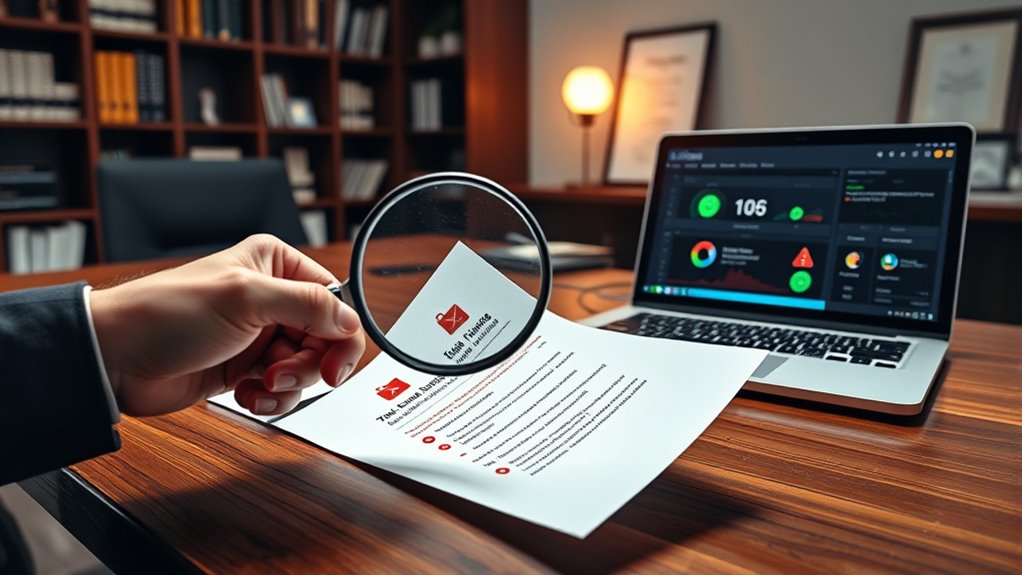When you get a data breach notice, verify its legitimacy by checking sender details and official sources. Document key details like the source, affected data, and time received. Isolate affected devices to prevent further damage, and assess the scope of the breach. Review legal reporting requirements and notify impacted individuals with clear guidance. Implement recovery steps and strengthen your security measures. Continuing further can help you understand how to respond more effectively and prevent future incidents.
Key Takeaways
- Verify the legitimacy of the breach notice through official channels before taking action.
- Immediately isolate affected systems to prevent further data loss and preserve evidence.
- Notify impacted individuals and stakeholders promptly, providing clear guidance and support options.
- Review and document all response actions, ensuring compliance with legal and regulatory reporting requirements.
- Strengthen security measures by applying patches, updating protocols, and enhancing monitoring to prevent future breaches.
Confirm the Legitimacy of the Breach Notice

To confirm the legitimacy of a data breach notice, start by verifying the source. Don’t accept unsolicited emails or messages at face value. Check the sender’s email address, website URL, and contact details to guarantee they match official organization channels. Visit the company’s official website or contact them directly using verified contact information—avoid links or phone numbers provided in the notice. Look for signs of authenticity, such as proper branding and clear language. Be cautious of urgent language or requests for personal information. Confirming legitimacy helps prevent falling victim to scams or phishing attempts that mimic breach notices. Reviewing digital literacy programs can also improve your ability to recognize authentic communications. It’s important to stay informed about common cybersecurity threats to better identify suspicious activity. Understanding data breach response procedures can guide your actions if a breach occurs. Familiarizing yourself with security best practices can help you respond more effectively to potential threats. Developing cybersecurity awareness skills enables you to better protect your personal and organizational data. Only proceed with further actions once you’re confident the notice is genuine. This step is vital to protect yourself and your organization from additional risks.
Document and Record Key Details

When a data breach occurs, documenting and recording key details is essential for effective response and future reference. You should log the date and time you received the breach notice, along with the source and any identifying information. Record what data was compromised, including types and scope, and note affected systems or departments. Capture details about your initial response actions, such as disconnecting devices or activating your incident team. Keep track of communications with authorities, affected individuals, and internal teams. Document any legal or regulatory notifications made, along with deadlines. This thorough record helps ensure compliance, supports investigations, and improves your response plan. Additionally, maintaining user consent management records can help demonstrate compliance with privacy policies. Implementing dynamic communication exercises can improve team coordination and clarity during incident management. Conducting regular training sessions for your response team can further enhance preparedness. Clear, organized documentation minimizes confusion and provides a solid foundation for managing the breach effectively. Incorporating appropriate security measures can further mitigate risks and prevent future incidents.
Disconnect and Isolate Affected Devices

Immediately after confirming the breach, you should disconnect affected devices from the internet to prevent further unauthorized access. Unplug network cables, disable Wi-Fi, and turn off any remote access features. This step halts the attacker’s ability to continue stealing data or spreading malware. If possible, isolate these devices physically from the rest of your network by removing them from shared drives or segments. Document which devices are affected and the actions taken. Avoid turning devices off abruptly if you plan to preserve volatile memory for investigation, but prioritize disconnecting from online access first. This containment not only limits damage but also preserves evidence for later analysis. Rapid isolation is vital to gaining control and preventing the breach from worsening. Additionally, understanding network segmentation can help contain breaches more effectively by limiting attacker movement within your systems.
Assess the Scope and Impact of the Breach

You need to identify which data was compromised to understand the breach’s scope. Assess the potential risks to affected individuals, such as identity theft or financial loss. This evaluation helps determine your next steps and necessary notifications. Additionally, understanding the data breach process can help you respond more effectively and prevent future incidents. Recognizing the importance of personal growth can also support building resilience and better handling such stressful situations. Monitoring industry trends, such as the rise of breakfast delivery options, can also provide insights into emerging risks and vulnerabilities. Being aware of juice cleanse and detox practices can also inform preventive measures related to data security and health-related information. Staying current with security best practices can further strengthen your response and safeguard sensitive data.
Data Types Compromised
Understanding which types of data were compromised is crucial for evaluating the breach’s scope and potential impact. You need to identify exactly what information was accessed or stolen to determine the severity. Here are key data types to consider:
- Personal identifiers like names, addresses, and Social Security numbers
- Financial information such as credit card or bank account details
- Health records protected under HIPAA or similar regulations
- Login credentials, including usernames and passwords
- Sensitive business data or trade secrets
Knowing the specific data involved helps you assess risks like identity theft, financial fraud, or legal compliance issues. Recognizing the importance of data classification can help prioritize your response efforts effectively. This knowledge also guides your next steps, including notifying affected individuals and implementing targeted security measures. Staying attentive to how on-device AI capabilities can also improve your response and mitigation strategies. These technologies can assist in detecting anomalies and identifying patterns that indicate ongoing threats. Stay focused on what data was impacted to effectively manage the breach’s consequences.
Potential Risks Identified
Evaluating the scope and impact of a data breach is essential to determine the potential risks to affected individuals and your organization. You need to identify which data was accessed or stolen—whether it’s personal identifiers, financial information, or health records—and understand how extensive the breach is. This helps you gauge the severity and potential consequences, such as identity theft, financial fraud, or reputational damage. Consider the legal thresholds for notifications based on the data involved and your jurisdiction. Consulting cybersecurity and legal experts ensures you understand your obligations. By accurately assessing these risks, you can prioritize response efforts, inform affected parties properly, and implement targeted measures to mitigate further harm. Additionally, understanding the importance of backup systems can help prevent data loss and facilitate recovery efforts following a breach. Incorporating incident response plans that are regularly tested can further enhance your organization’s ability to respond swiftly and effectively.
Review Legal and Regulatory Requirements

You need to identify your legal obligations for reporting the breach, including any jurisdiction-specific timelines. Make certain you understand the requirements for notifying authorities and affected individuals to avoid penalties. Keep detailed records of your compliance processes to demonstrate adherence if needed.
Legal Obligations for Notification
Legal obligations for notification require organizations to comply with specific laws and regulations that dictate when and how you must inform authorities and affected individuals about a data breach. You need to understand the legal landscape to avoid penalties and maintain trust. Key points include:
- Recognizing which laws apply, like GDPR, HIPAA, or state breach laws.
- Meeting mandatory reporting deadlines, such as 72 hours under GDPR.
- Providing clear, accurate information in your notifications.
- Ensuring documentation of all compliance actions taken.
- Consulting legal experts to confirm your obligations are met.
Failing to follow these requirements can result in fines, legal action, or damage to your reputation. Staying informed and acting swiftly helps you navigate your legal responsibilities effectively.
Jurisdiction-Specific Reporting Timelines
Understanding the specific reporting timelines mandated by different jurisdictions is essential after a data breach. You need to be aware of how quickly you’re required to notify authorities and affected individuals. For example, under GDPR, you must report a breach within 72 hours of becoming aware of it. In contrast, some U.S. states, like California, mandate notification within 45 days. Other regions may have longer or shorter windows depending on local laws. Failing to meet these deadlines can result in hefty fines and legal consequences. Consequently, review the relevant regulations carefully to ensure compliance. Track the exact date you discovered the breach and set internal deadlines accordingly. Staying ahead of jurisdiction-specific timelines helps you avoid penalties and demonstrates your commitment to transparency and responsible breach management.
Documenting Compliance Processes
To guarantee compliance after a data breach, it’s essential to thoroughly document all processes related to meeting legal and regulatory requirements. Proper documentation not only demonstrates your due diligence but also supports legal and audit purposes. Keep detailed records of every step, from breach detection to notification. This includes timelines, communication logs, and actions taken. Accurate documentation helps you track compliance deadlines and fulfills reporting obligations. It also safeguards your organization during investigations or audits. Make sure your records are organized, secure, and easily accessible. Regularly review and update your documentation processes to adapt to changing regulations. This proactive approach minimizes legal risks and reinforces your commitment to accountability.
- Record breach detection and response actions
- Log all communication with authorities and stakeholders
- Track compliance deadlines and notification timelines
- Save copies of breach notifications sent
- Maintain secure, organized records for audits
Notify Affected Individuals and Stakeholders

Once you’ve confirmed the breach and assessed its impact, prompt and transparent communication with affected individuals and stakeholders becomes essential. Reach out quickly with clear, honest information about what happened, what data was compromised, and the potential risks involved. Use straightforward language and avoid technical jargon to ensure everyone understands the situation. Provide guidance on protective measures, like changing passwords or monitoring accounts, and inform them about any support services available, such as credit monitoring. Designate a point of contact for questions and follow-up. Remember, timely notification helps build trust, demonstrate responsibility, and reduce the likelihood of legal repercussions. Being transparent shows you’re taking the breach seriously and prioritizing the safety and well-being of those affected.
Implement Mitigation and Recovery Measures

After confirming the breach and evaluating its scope, you should immediately isolate affected systems to prevent further data loss. This containment limits damage and stops hackers from accessing additional information. Next, eradicate the root cause by applying security patches, updating software, and removing malicious code. Restore systems from verified backups to ensure data integrity. To strengthen defenses, implement measures like multi-factor authentication, intrusion detection systems, and enhanced monitoring. Keep a close eye on your network for signs of lingering malicious activity or new breaches. Regularly review system logs, set up alerts for suspicious behavior, and tighten access controls. These steps help contain the breach, prevent recurrence, and protect your organization’s data assets effectively.
Conduct a Post-Incident Review

Conducting a post-incident review allows you to analyze what went wrong during the breach and identify areas for improvement. Start by gathering all relevant evidence, including logs, communications, and documentation of your response steps. Review how the breach was detected, contained, and communicated. Identify gaps in your security measures, incident response plan, and employee training that may have contributed to the breach or delayed your response. Discuss what worked well and where weaknesses lie. Use these insights to update your incident response plan, improve security protocols, and strengthen staff training. This review ensures you learn from the incident, reduce the risk of future breaches, and enhance your overall cybersecurity posture. Regular reviews help turn a crisis into a catalyst for stronger defenses.
Strengthen Security and Prevent Future Incidents

To effectively prevent future incidents, you need to proactively strengthen your security measures by identifying vulnerabilities and implementing targeted solutions. Start by conducting thorough vulnerability assessments to pinpoint weak spots. Then, apply security patches and updates promptly to fix known issues. Implement multi-factor authentication across all systems to add an extra layer of protection. Regularly review and update your access controls, ensuring only authorized personnel have permissions. Enhance monitoring tools to detect suspicious activity early. Additionally, train your staff on security best practices and common threats. These steps help you build a resilient security posture and reduce the risk of repeat breaches. Stay vigilant, adapt your defenses, and continuously improve your security strategies to stay ahead of evolving threats.
Frequently Asked Questions
How Long Should I Wait Before Changing My Passwords After a Breach?
You should change your passwords immediately after learning about a breach. Don’t wait—acting quickly reduces the risk of unauthorized access and identity theft. Use strong, unique passwords for each account, and consider enabling multi-factor authentication for added security. Regularly update your passwords, especially if you hear about new breaches affecting services you use. Prompt action helps protect your personal information and minimizes potential damage.
What Are the Common Signs Indicating Ongoing Malicious Activity Post-Breach?
If you notice unusual login attempts or unfamiliar account activity, you might have ongoing malicious activity after a breach. For example, a company experienced repeated unauthorized access even after initial containment, signaling persistent threats. Other signs include unexpected system slowdowns, new user accounts, or strange emails sent from your account. Stay vigilant for these indicators, as they suggest attackers are still active and may try to exploit your systems further.
Should I Contact Law Enforcement Immediately After Discovering a Data Breach?
Yes, you should contact law enforcement immediately after discovering a data breach. Reporting the incident promptly helps authorities investigate, trace the source, and potentially prevent further damage. It also guarantees you’re complying with legal or regulatory requirements. Provide law enforcement with all relevant evidence and details to support their investigation. Acting quickly demonstrates your commitment to transparency and can help mitigate risks for affected individuals.
How Can I Verify if My Personal Data Was Specifically Compromised?
Verifying if your personal data was compromised is like fishing with a fine net—you need precise tools. Check for any official breach notifications or alerts from the organization involved. Review your accounts for suspicious activity, such as unfamiliar transactions or logins. Use security tools like credit monitoring services and request your credit report. Stay alert for phishing emails or messages that ask for personal info, and act quickly if anything seems suspicious.
What Steps Should I Take if I Receive Suspicious Follow-Up Communications?
If you receive suspicious follow-up communications, don’t respond or click on any links. Verify the sender’s identity by contacting the organization directly through official channels. Report the suspicious message to your IT or security team if applicable. Keep a record of the communication, including screenshots. Use security tools like antivirus software to scan your device and change passwords for affected accounts to protect your information from further compromise.
Conclusion
After a data breach, acting quickly is essential. Did you know that 60% of small businesses close within six months of a cyber attack? By confirming the breach, containing damage, and strengthening your security, you can reduce the risk of future incidents. Stay proactive and vigilant—your responsiveness now can make all the difference in protecting your data and your business’s future. Don’t wait; take action and learn from each breach.









